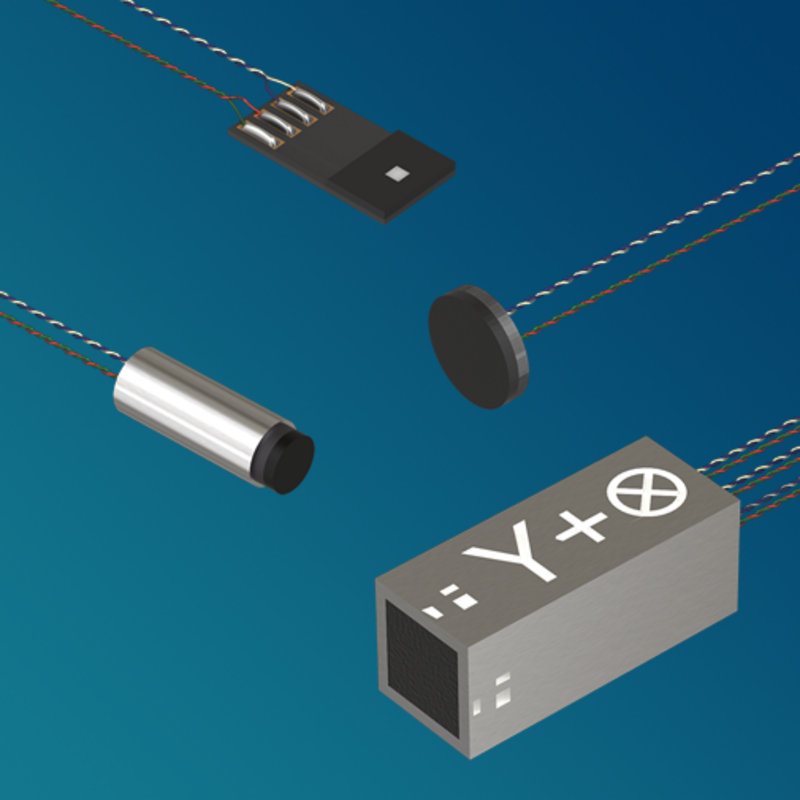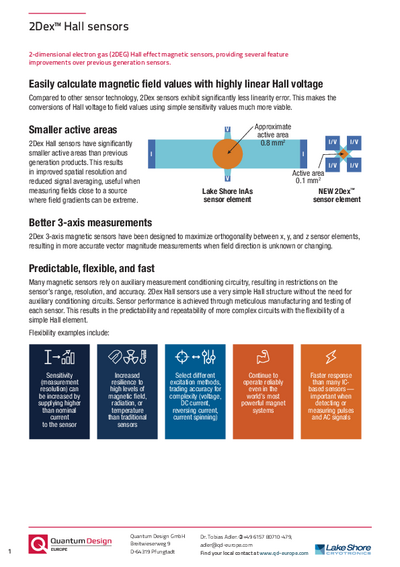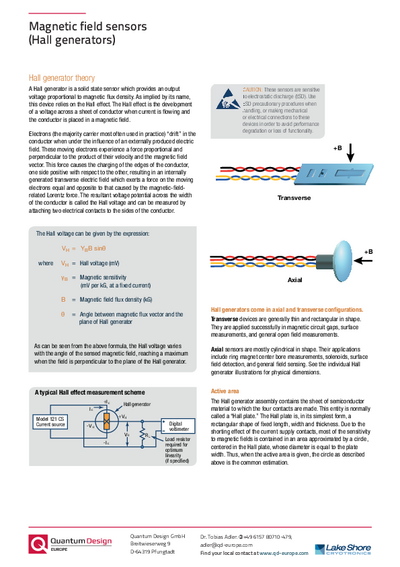Hall (magnetic) sensors
from Lake Shore CryotronicsHall effect sensors are measuring or detecting magnetic fields electronically. They are providing an output voltage proportional to the magnetic flux density. This device relies on the Hall effect. The Hall effect is the development of a voltage across a sheet of conductor when current is flowing, and the conductor is placed in a magnetic field. We offer a range of Hall sensors for various applications. In all cases, these sensors go beyond the application of simple magnetic presence detection such as those used in encoders, contactless switches, and electronic compasses. Lake Shore sensors are useful for field measurement applications, where field value, direction, and polarity are of interest.
- Single or 3-axis configurations
- Wide operating temperature range
- Plug-and-play version available for teslameters and gaussmeters
Further information
A Hall sensor is a 4-lead device. The control current (IC) leads are normally attached to a current source such as the Lake Shore Model 121. The Model 121 provides several fixed current values compatible with various Hall sensors.
The Hall voltage leads may be connected directly to a readout instrument, such as a high impedance voltmeter, or can be attached to electronic circuitry for amplification or conditioning. Device signal levels will be in the range of microvolts to hundreds of millivolts.
The Hall sensor input is not isolated from its output. In fact, impedance levels on the order of the input resistance are all that generally exist between the two ports. To prevent erroneous current paths, which can cause large error voltages, the current supply must be isolated from the output display or the downstream electronics.
|
| ||||
| What makes this work? | Thin-film technology using a 2‑dimensional electron gas (2DEG) structure | Indium arsenide bulk material, doped for high stability | Indium arsenide bulk material, doped for high sensitivity | Gallium arsenide thin film |
| Temperature range | 1 K* to 402 K | 1.5 K to 375 K | 208 K to 373 K | 233 K to 402 K |
| Interchangeability | Good—narrow range of sensitivity values, excellent linearity, and small offset voltage | Poor—sensitivity range is large enough to require knowledge of the average sensitivity value | Poor—sensitivity range is large enough to require knowledge of the average sensitivity value | Poor—sensitivity range is large enough to require knowledge of the average sensitivity value |
| Ruggedness | Good | Poor | Poor | Good |
| Lake Shore instrument compatibility | F71 or F41 teslameter with plug-and-play sensors—full sensor calibration and temperature compensation providing accuracy equivalent to a full teslameter probe | 425 or 475 gaussmeter using HMCBL cable; field conversion accomplished with single sensitivity value only, meaning linearity and temperature compensation is not carried out by the gaussmeter | 425 or 475 gaussmeter using HMCBL cable; field conversion accomplished with single sensitivity value only, meaning linearity and temperature compensation is not carried out by the gaussmeter | None |
| Planar Hall effect | None, making these sensors ideal for measuring fields with unknown orientation | Significant—bulk material produces enough of a planar Hall effect that fields with known directions are required for accurate measurements | Significant—bulk material produces enough of a planar Hall effect that fields with known directions are required for accurate measurements | Some—thin film elements may exhibit small amounts of planar Hall effect error |
| Sensitivity at nominal current | 50.5 to 52.5 mV/T | 5.5 to 11 mV/T | 55 to 125 mV/T | 110 to 280 mV/T |
| Sensitivity temperature coefficient | 200 ppm/°C | 50 ppm/°C | 800 ppm/°C | 600 ppm/°C |
| Nominal drive current | 1 mA | 100 mA | 100 mA | 1 mA |
| Typical input resistance | 800 Ω | 2 Ω | 2 Ω | 750 Ω |
| Typical input resistance temperature coefficient | 0.7%/°C | 0.15%/°C | 0.18%/°C | 0.2%/°C |
| Best offset voltage (field equivalent) | ±25 µV (0.5 mT) | ±50 µV (4.5 mT) | ±75 µV (0.6 mT) | ±2.8 mV (10 mT) |
Specifications
2Dex™ Hall Sensors
- Multiple package types
- Small active areas
- Single or 3-axis configurations
- Suitable for extreme environments (temperature, radiation, vacuum)
- Plug-and-play version available for direct connection to Lake Shore F71/F41 teslameters
2Dex™ Plug-and-Play Hall Sensors
- Multiple package types
- Small active areas
- Single or 3-axis configurations
- Plug-and-play sensors
- Inline connector
- Easy extension
- Multiple packages available
- Options for high stability or sensitivity
- Compatible with Lake Shore 400 Series gaussmeters
Downloads
Contact

Navigation
Categories
Contact
Quantum Design GmbH
Roddarestigen 3
SE 182 35 Danderyd
Sweden
| Phone: | +46 8 41071791 |
| E-mail: | nordicqd-europe.com |




